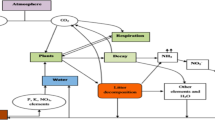Abstract
The importance of litter to nutrient and organic matter storage and the possible influence of species selection on soil fertility in ten stands each consisting of a separate tree species were examined in this study. The plantations had been grown under similar conditions in an arboretum in the Luquillo Experimental Forest, Puerto Rico. The species involved were: Anthocephalus chinensis, Eucalyptus × patentinervis, E. saligna, Hernandia sonora, Hibiscus elatus, Khaya nyasica, Pinus caribaea var. hondurensis, P. elliottii var. densa, Swietenia macrophylla, and Terminalia ivorensis. After 26 yr, litter mass ranged from 5 mg ha-1 in the H. sonora stand to 27.2 Mg ha-1 in the P. caribaea stand. Nutrients in the litter (N, P, K, Ca, and Mg) also varied widely, but stands were ranked in different order when ranked by nutrients in the litter than then ranked according to accumulation of mass. Only E. saligna and A. chinensis stands were ranked similarly in accumulation of both nutrients and mass, and the stand of H. elatus was ranked higher with respect to nutrient accumulation than to accumulation of mass. The nutrient concentration in standing leaf litter generally increased in the order of recently fallen <old intact< fragmented. Nutrient concentration of standing leaf litter appears to increase with age and depth in the litter layer. The amount of nutrients stored in the litter compartment of these plantations was in the same order of magnitude as the quantity of available nutrients in the top 10-cm of mineral soil. Total litter mass was negatively correlated with the mass-weighted concentration of N, K, and Mg. The same relationship was found for Ca in the leaf litter and N in the fine wood litter compartments. In some stands (notably P. caribaea, P. elliottii, and E. saligna), leaf litter derived from species other than the species planted in that particular stand had higher nutrient concentration than leaf litter from the planted species. Soils of the 10 stands were classified in the same soil series and had similar texture (clay soils). However, significantly different chemical characteristics were found. Results obtained by analysis of covariance and by limiting comparisons to adjacent stands with similar soil texture, indicate that different species have had different influences on the concentration of available nutrients in soil.
Similar content being viewed by others
References
Binkley D 1986 Forest nutrition and management. John Wiley and Sons, New York, 290 p.
Black C A (Ed.) 1965 Methods of soil analysis. pp 562–566. Agronomy 9, Part 1, American Society of Agronomy Inc. and Soil Science Society of America. Madison, WI.
Boccheciamp R A 1977 Soil Survey of Humacao Area of Eastern Puerto Rico. National Cooperative Soil Survey, USDA Soil Conservation Service, Washington, DC.
Bowen G D and Nambiar E K S (Eds.) 1984 Nutrition of plantation forests. Academic Press, New York, 516 p.
Brenner J M and Mulvaney C S 1982 Nitrogen-total. In Methods of Soil Analysis: Chemical and Microbiological Properties. Eds. A LPage, R HMiller and D RKeeney. pp 595–624. Agronomy 9, Part 2. American Society of Agronomy Inc. and Soil Science of America. Madison, WI.
Chapman H D and Pratt P F 1979 Métodos de análisis para suelos, plantas y aguas, pp 102–103. Editorial Trillas, Mexico City, Mexico.
Evans J 1982 Plantation forestry in the tropics. Clarendon Press, Oxford, UK.
Fearnside P M and Rankin J M 1985 Jari revisited: Changes and the outlook for sustainability in Amazonia's largest silvicultural estate. Interciencia 10, 121–129.
Francis J K 1989 The Luquillo Experimental Forest Arboretum. USDA Forest Service Southern Forest Experiment Station Research Note. New Orleans, LA. 8 p.
Gosz J R 1984 Biological factors influencing nutrient supply in forest soils. In Nutrition of plantation forests. Eds. G DBowen and E K SNambiar. pp 119–146. Academic Press, New York.
Holdridge L R 1967 Life zone ecology. Tropical Science Center, San José, Costa Rica, 206 p.
Hunter A H 1974 International soil fertility evaluation and improvement: Laboratory procedures. Department of Soil Science, North Carolina State University, Raleigh.
Jordan C F 1985 Nutrient cycling in tropical forest ecosystems. John Wiley and Sons, New York.
Lanly J P 1981 Los recursos forestales de la América Latina tropical, Informe Técnico No. 1; Forest resources of tropical Asia, Technical Report No. 2; Forest resources of Tropical Africa parts 1 and 2, Technical Report No. 3. UN 32/6.1301–78–04, Food and Agriculture Organization, Rome, Italy.
Lugo A E (1991) Comparison of small tropical tree plantations with natural forests of similar age. Ecological Monographs. (In press.)
Lugo A E, Wang D and Bormann F H 1990 A comparative analysis of biomass production in five tropical tree species. Forest Ecology and Management 31, 153–166.
Luh Huang C Y and Schulte E E 1985 Digestion of plant tissue for analysis by ICP emission spectroscopy. Commun. Soil Science Plant Analysis 16, 943–958.
Melillo J M, Aber J D and Muratore J F 1982 Nitrogen and lignin control of hardwood leaf litter decomposition dynamics. Ecology 63, 621–626.
Nelson D W and Sonmers L E 1982 Total carbon and organic matter. In Methods of Soil Analysis: Chemical and Microbiological Properties. Eds. A LPage, R HMiller, and D RKeeney. pp 539–579. Agronomy 9, part 2. American Society of Agronomy Inc. and Soil Science Society of America, Madison, WI.
Zobel B J, Wyk G V and Stahl P 1987 Growing exotic forests. John Wiley and Sons, New York, 508 p.
Author information
Authors and Affiliations
Rights and permissions
About this article
Cite this article
Lugo, A.E., Cuevas, E. & Sanchez, M.J. Nutrients and mass in litter and top soil of ten tropical tree plantations. Plant Soil 125, 263–280 (1990). https://doi.org/10.1007/BF00010665
Received:
Issue Date:
DOI: https://doi.org/10.1007/BF00010665
Key words
- Anthocephalus chinensis
- Eucalyptus × patentinervis
- E. saligna
- Hernandia sonora
- Hibiscus elatus
- Khaya nyasica
- litter
- Luquillo Experimental Forest
- nutrient cycling
- Pinus caribaea var. hondurensis
- P. elliottii var. densa
- Puerto Rico
- soil fertility
- Swietenia macrophylla
- Terminalia ivorensis
- tropical tree plantations




